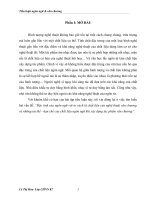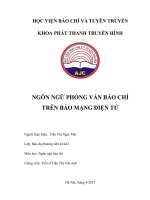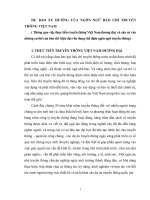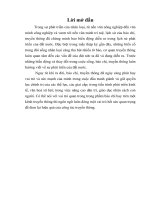Tiểu luận ngôn ngữ và văn hóa
Bạn đang xem bản rút gọn của tài liệu. Xem và tải ngay bản đầy đủ của tài liệu tại đây (227.16 KB, 7 trang )
HUE UNIVERSITY
INFORMATICS AND OPEN INSTITUTE
--------------
ASSIGNMENT ON
LANGUAGE AND CULTURE
TOPIC:
CROSS CULTURAL COMMUNICATION BARRIERS IN
WORKPLACE
Lecturer:
Nguyễn Văn Tuấn
Student:
Lê Văn Hưng - 7052900456
Class:
Nghệ An 6
I. Introduction
Cultural factors play an important role as invisible barriers. With the
continuous globalization the firms should focus on eliminating the invisible
cross cultural communication barriers .Solving these barriers is important in
order to foster the organizational climate .This will also create opportunities
for expansion of the organization and widen their geographical outlook.
Many serious problems may arise when people from different countries,
races, values, corners of world come together. Working in multicultural
team involves many challenges, disagreements and conflicts. These
challenges and conflicts affect the performance of the individuals and the
entire firm to a certain degree. In a multicultural internal environment the
firms need to find out a solution to bring a clarity in communication. Cross
cultural communication where people belonging to diverse cultures being in
communication with each other needs to be effective in order to avoid
disagreements and conflicts and in turn achieve the business objectives. In
order to make cross cultural communication effective, a firm has to
understand the barriers involved in cross cultural communication process &
identifying means of overcoming such barriers in order to make cross
cultural communication effective.
II. Content
1. Cross cultural communication barriers in work place
1.1.
Misunderstanding
Misunderstanding is the foremost barrier to communication in a
multicultural environment .This is common among people of different
cultural backgrounds whose values and beliefs vary. The variation in the
different cultures results in high level of anxiety and uncertainty and end up
into the misunderstanding. The misunderstanding which has been raised due
to anxiety and uncertainty continues in their entire tenure.
1.2.
Norms and Roles
Norms are the culturally defined rules for determining the acceptable and
appropriate behavior. Individuals they themselves frame rules for
themselves and also expect others to do so. Each and every culture has it’s
owns norms and they have their own acceptable and appropriate behavior.
People working in multicultural environment often fail to understand the
norms of the other culture and act accordingly. Roles are a setoff norms
applicable to specific groups .In particular culture different roles are
assigned to men and women, children and parents/guardians, husbands and
wives. These roles vary from and culture to culture and in a multicultural
team one can find several violations of the roles. This further leads to
anxiety and the communication process is interrupted.
1.3.
Beliefs and values
Beliefs and values are different from person to person. In a globalized
working community each and every person’s beliefs and values depend on
his culture .The cross cultural belief and value prevailing should be known
to the person in order to communicate efficiently.
1.4.
Stereotyping
Value judgments about people. Inadequate information about the people
leads to unintelligent choices in the cross cultural communication. Cultural
stereotypes exaggerate or overgeneralize what we perceive about people,
and leads to increase anxiety. Every individual enacts one stereotype on
other individuals or group of people. Generally stereotypes are born out of
fear of the group we stereotype or lack of knowledge of the group .These
stereotypes are the major reasons for difference of opinions about the
opposite culture and leads to miscommunication
1.5.
Ethnocentrism
Thinking about our own culture, our group behavior as the standard against
all the other groups. One’s own cultural experience unintentionally makes
us to feel that our culture is distinctive. This ethnocentrism increases the
level of the anxiety .In work places the ethnocentrism is directly
proportional to anxiety level. Multicultural team members face a lot of
issues due to ethnocentrism.
2. Over coming the cross cultural barriers
Measures to overcome barriers in cross cultural communication
Cross cultural communication competence enables an organization to
achieve objectives while according due respect to values, norms, beliefs of
the people being affected by its operations. A business organization has to
develop cross - cultural competence in organizational set up to overcome
the above mentioned barriers to cross cultural communication.
3. Improving the cross cultural comptetence
Cross-cultural competence is defined as the ability to participate in a set of
activities the core of which happens to a common communication code.
This ability is aided by knowledge, skills & attitudes. Successful
Development of Cross-cultural competence rests on three pillars. These
components that facilitate orderly cross cultural communication would be
Cross-cultural sensitivity, cross-cultural awareness &cross-cultural ability.
The affectionate aspect of cross-cultural communication is identified as
intercultural sensitivity. This aspect is to be developed in order to equip
individuals with the ability to appreciate other cultures’ differences.
Through the development of cross-cultural sensitivity, an individual would
be able to grasp self-concept, neutrality & self- possession. The cognitive
aspect of cross-cultural communication is known as cross-cultural
awareness. Intercultural awareness results in enhancing not only culturalawareness but also self- awareness in the process.
The cross cultural competence could be improved through the following
methods:
3.1.
Cross cultural knowledge training
Employees need to recognize and admit the existence of differences
between cultures. The differences in values beliefs, perceptions,
interpretations. Employees should be given a basic cross culture training
which will make them aware of the cross culture in the work place.
3.2.
Language Training
Language barrier is the greatest problem encountered in multi-cultural
team .Language training should be given for those who have more chances
of coming into contact with foreigners
3.3.
Enforcement of mutual benefit policy
Organizations should insist on mutual benefits for all the cultures in the
work place. Employees while getting similar benefits as like employees of
other culture will face a win- win situation
III. Conclusion
Organizations should focus on establishing a new enterprise culture. A
universally accepted culture in which one understands the other person’s
values and beliefs and respects it. The top level management should commit
in building organizational climate without conflicts and difference of
opinions. Improving the employees cross cultural competence through cross
cultural knowledge training and insisting on the mutual benefit policy which
is a win- win situation for cross cultural population in workplace. Culturally
competent involves a lot of learning about the cross cultures which will
overcome the cross cultural barriers.
REFERENCES
[1] Albert, R.D. (1994). Cultural diversity and intercultural training in
multinational organizations. In Wiseman, R.L and shutter, (eds)
Communicating in multinational organizations. International and
intercultural communication annual. Vol xviii (153-165) London: Sage
publications.
[2] Dr. P.Srinivas Rao, Dr. Padma Charan Sahu, Dr. Sathyapriya J and
Vandhana.R, “A Study on Trust and Conflict Resolution in CrossCulture”, International Journal of Advanced Research in Management
(IJARM), Volume 4, Issue 3, 2013, pp. 43 – 49. ISSN Print: 0976 –
6324, ISSN Online: 0976 – 6332.
[3] Deblina Saha Vashishta and Dr. B.Balaji, “Cross Cultural Study of
Customer Satisfaction with Self Service Technology in Retail Settings
of India and Indonesia”, International Journal of Management (IJM),
Volume 4, Issue 5, 2013, pp. 139 - 152, ISSN Print: 0976-6502,
ISSN Online: 0976-6510.
[4] Adler, N.J and Graham, J.G. (1989). “Cross cultural interaction: The
international comparison fallacy?’’. Journal of international business
studies, 20 (3), pp.226-232.
[5] Mary, M. (1993). “Cross –Cultural communication for managers”.
Business horizons, 36(3), pp. 69.
7









